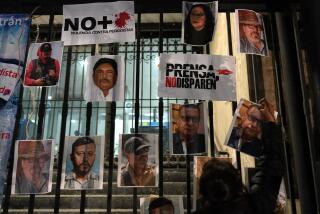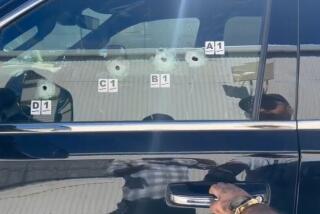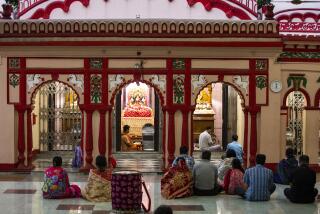Documentary : Scrambling for Safety Amid a Merciless Mob : No one was spared as Hindu militants stormed a mosque in India. ‘No camera!’ they screamed before attacking journalists.
- Share via
AYODHYA, India — A morning newspaper headline called it the “Temple of Doom,” but when I arrived here Sunday morning at the most controversial religious site in all India, Ayodhya looked more like a Hindu Woodstock.
Hundreds of thousands of barefoot Hindu pilgrims, half-naked holy men, well-heeled businessmen and elegant, sari-clad women blanketed the dusty hills that surround this small city. Saints came marching in, chanting and singing as they snaked down crowded alleys and streets in joyous celebration to Lord Rama, the fabled Hindu warrior-king and demigod.
White bearded Hindu priests and long-haired swamis were draped in ascetic robes ranging from yellow to saffron. Some wore long headbands or monk-like hoods. Others dripped dreadlocks down their back. Foreheads gleamed with brilliant flashes of vermilion, sandalwood paste or gray ash. A few even sported colorful sixties-style lapel buttons with the Hindi script for om , the Hindi mantra for meditation.
The only sign of trouble was the hundreds of police in ill-fitting brown uniforms who stood shoulder-to-shoulder behind steel and barbed-wire barricades protecting the center of the Hindus’ devotion: a shabby, utterly undistinguished, red-brown, three-domed mosque.
Fundamentalist Hindus claim that the mosque was built by Mogul invaders in 1528 over the birthplace of Lord Rama. There is no proof Rama was born here, or even that he existed. But fanatics don’t look for evidence, and their beliefs have unleashed what threatens to be South Asia’s latest holy war.
A five-day Hindu ceremony to consecrate a concrete platform where a Hindu temple would be built was to start at precisely 12 minutes after noon. Fellow reporters and I moved easily through the crowd, gathering in a fenced compound around the platform, chatting and taking photographs.
“Are you BBC?” a man asked me politely. No, I replied, nothing so grand. The British Broadcasting Corp. is a revered institution in India, its radio broadcasts and now TV news heard by millions in the smallest villages and respected through the land.
Someone told me that one of the Hindu leaders manning the blaring microphones had earlier attacked the BBC for announcing that riots had begun in Ayodhya. Actually, the “Beeb” had simply shown file TV footage of an October, 1990, riot in which police had tear-gassed and shot at militant Hindu mobs trying to assault the disputed mosque. Subsequent riots across India killed more than 1,000 people.
Molly Moore, the Washington Post correspondent, told me that she and Christopher Thomas, the New Delhi correspondent for the Times of London, were going on top of a nearby roof to watch. Thanks, I said, I’ll stay here to be close to the action. It looks safe.
Suddenly, on my right, wild-eyed, shrieking men began pushing and fighting with police at the gate to the compound. A few broke through, and then dozens began racing by, shouting: “Dar Sri Lam! Dar Sri Lam!”-- Hindi for “Hail Lord Rama.” Someone shoved me hard and I fell off the gravel pile where I stood. An accident, I thought, in the heat of the moment.
In seconds, a rain of rocks pelted the police inside the mosque, clattering on tin roofing. I saw a line of police with rifles run behind the first metal barricade, and, fearful they would begin firing, I retreated behind another pile of stones and pulled out my camera.
“No camera! No camera!” a man screamed at me, grabbing at the instrument. I walked away and snapped a half dozen photos as a youth, waving a large saffron flag, appeared from nowhere climbing atop one of the mosque’s onion domes. This wasn’t supposed to happen, I thought, and began writing notes as the crowd roared from all sides.
Suddenly, I was whacked hard on the back with a bamboo staff. “No cameras, BBC!” men in yellow robes screamed, pushing and grabbing at me and my notebook. From the corner of my eye I saw Edward Gargan, the New York Times correspondent, pushed to the ground. Nearby, an Indian TV cameraman ducked as someone viciously swung his heavy camera tripod at him, shrieking in Hindi.
Still unsure at what was happening, I tried to walk up to the mosque, stopping to stuff my camera in my bag. The frenzied mob already had pulled down a corner of the barricades and was surging inside. Hundreds ran up and climbed barefoot over the barbed wire. The police had disappeared.
Half a dozen youths with steel rods and bamboo sticks began running toward me. I quickly turned and ran. Just outside the gate I saw dozens of police standing and watching from the driveway of a two-story building. I joined them for a moment, then someone grabbed me and pointed.
Peter Heinlein, the Voice of America correspondent, was half-staggering, half being carried toward me. His baseball cap and radio gear were gone. Blood covered his bald head, drenched his gray T-shirt and still oozed from the back of his head where he’d been clubbed. I took his left arm and helped bring him inside the compound as the police looked on.
Gargan, who had driven to Ayodhya with Heinlein, appeared beside me and began screaming at the onlookers to give the VOA man air. I handed Gargan my bottle of water to help wash the wounds. He said he would take Heinlein to the hospital.
Up above, crowds had gathered on the multilevel roof. I ran to the back of the building and up two dark flights of stairs. From the top, I could see the mob swarming over the mosque like ants. The barricade was coming down, and its steel poles were being used as pikes to attack the structure. To my amazement, I saw others smash the domes and walls with pickaxes, shovels, and sharp-edged tridents, the symbol of Shiva, the Hindu god of destruction. Still others used grappling hooks to pull down police guard towers. The attack clearly had been planned.
Within seconds, a group of women began shrieking at me. A fat woman in a red sari picked up a brick and heaved it at me without warning. It landed on my right ankle. She chased me as I quickly backed off, climbed down a ladder and the stairs to the courtyard.
Other journalists and wounded were coming in. A Swiss photographer told me a man had tried to strangle him, screaming: “You are Muslim! You are Muslim! Go back to Pakistan!” A German photographer bandaged his finger, wounded when someone smashed his camera with a rock. Soon a dozen of us stood nervously, hugging a wall after someone on the roof began lobbing rocks down at us.
I walked down the driveway past the police three times, and each time was forced back when men began screaming or pushing at me. I went into the inner courtyard and tried to talk to a police colonel I assumed was in charge. He said nothing, and for the next two hours, as bedlam raged outside, he sat in a folding chair smoothing his mustache and staring at the wall.
More and more journalists arrived, each with a fearful tale. Later, I heard perhaps the most frightening. Sarah Brezinsky, a young, American, New Delhi-based free-lance photographer, also had been chased from the platform. She ran into an ashram, a Hindu dormitory, and into a roomful of women. They rolled her into a carpet and sat on her while an old woman stood guard at the wooden door, refusing time after time to let attackers in.
Four hours later, however, someone’s husband arrived and began screaming, “Out! Out!” pushing Sarah outside. Terrified, she ran into a nearby building where she collided with another man who began chasing her with a long sword. She outran him and finally escaped.
We had been at the impromptu police post for nearly two hours when we realized that the police with us were leaving. By then, Molly and Chris, my companions on the ride into town, had appeared. They had been chased from the rooftop, but were safe.
It was clear we weren’t safe in the building, however, as more and more angry Hindus appeared. A door in a back room opened onto a rocky field used as an open toilet, and a British reporter’s Indian assistant announced that his car was that way, only about 100 yards distant.
As we debated running for it, a crazed swami ran up and began shouting and waving a long steel bar over his head. He quickly ran off again, and Chris and I decided he was going for reinforcements. It was time to go. Eight of us walked across the field, trying not to run or look around.
At the car, a small, Indian-made Ambassador, five piled in the back seat and the rest up front. Go slow, don’t panic, we told the driver. He maneuvered only 20 yards before a brick hit the top of the car. A dozen men blocked the road and began pounding at the vehicle with rocks and sticks. Opening his window, the driver tried to talk, but they grabbed his shirt and began banging our windows. We opened the doors and they pulled us out roughly, pushing us and screaming for cameras. One man held a brick high over his head, threatening to hit a photographer. Someone yanked hard at my bag, but I pulled it back. We began to retreat back toward the field.
Suddenly, the driver shouted. A tall man with a steel helmet and walkie-talkie, and wearing a sport jacket and tie, was standing by him. I ran toward them. “Stay here,” the helmeted man said. “It is not safe.” He was the district magistrate, a senior civil official in a city taken over by rampaging mobs.
“Where should we go?” I asked. He led us around a corner where three blue busloads of police stood or squatted in the dust. A double wooden door swung open and we entered a police barracks for women. We were safe. It was just after 2 p.m.
For three hours we stayed, listening to static-filled BBC reports on portable short-wave radios, wondering about our missing colleagues and trying to persuade the police to escort us out of town. They refused, saying they had no orders.
The man in the tie had disappeared. We could see the smoke of fires blazing in nearby streets and still hear the roar of the mob at the mosque. Someone served us sweet tea. By now, we were 18 foreign and Indian journalists, sharing cigarettes and talking too loudly from the adrenaline.
Shortly before 5 p.m., Chris Thomas announced he had a deadline to meet. He’d walked outside, he said, and it looked OK. There was a brief debate. We were safe, but no one knew for how long, as nightfall approached. I trusted Chris, who has covered India for several years. I looked at Molly, and we said we would go. Everyone slowly agreed.
We left in small groups. Together with a newly arrived, bewildered-looking young correspondent from the Financial Times, Molly, Chris and I went first, walking slowly outside and hoping to find the car and driver we’d left at a road junction nine hours earlier. In the narrow, muddy lanes, we quickly got lost, but kept moving away from the city and toward the main road.
Hindus in twos, threes, and soon droves began joining us. Their mood now was celebratory, as if they’d won a football game, Molly said. Many carried bricks, chips of plaster, and even pieces of the steel barricade as souvenirs. Smiling and waving, I made it a point to talk to pilgrims as I walked, hoping to defuse any lingering anger. Men riding three and four deep roared by on motorcycles, shouting “Hail Lord Rama!” We responded in kind.
We walked for an hour as darkness fell and a nearly full moon rose, casting eerie shadows on the road and nearby fields. Several homes could be seen burning, but no one bothered us except police, who stood at several roadblocks and shouted lewdly at Molly. Two cars had been burned at one point, and bonfires of blazing tires poured acrid black smoke in the air. Someone pushed greasy flat-breads in our hands and cheered. We thanked him.
Somewhere in Feizerbad, a town about four miles away, a van pulled up and an Indian reporter took us the last mile to a hotel that had become the local press base.
Our car was still missing, so six of us piled into another Ambassador for the three-hour drive back to Lucknow, the state capital.
On the way, Sarah, the photographer who had been chased by a sword-waving fanatic, told me she’d been scared. Was I scared, she asked?
No, I began to say, knowing it was a lie. I stopped. “Any journalist who wasn’t scared today was stupid,” I told her.
Times Manila Bureau chief Drogin is on assignment in India.
More to Read
Sign up for Essential California
The most important California stories and recommendations in your inbox every morning.
You may occasionally receive promotional content from the Los Angeles Times.











